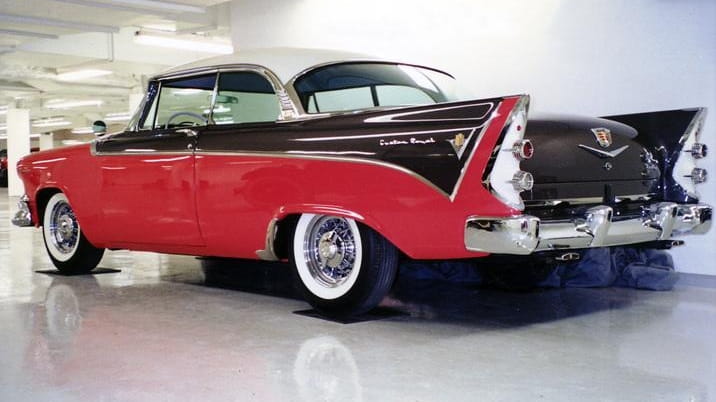Chrysler mid-century resurgence powered by fins and flash

The 1956 Dodge Custom Royal is representative of the direction Chrysler was headed: fins; flash; and fast times. Credit: Chrysler Group LLC
For Chrysler, the years 1955 and 1956 were pivotal.
A revolution was brewing within the organization that would eventually lead to major changes in both the style and substance for Chrysler's automobiles. The 1956 Dodge Custom Royal is representative of the direction the company was headed: fins; flash; and fast times. Although the fact that the car isn't particularly well known is not necessarily a case of the wrong product at the wrong time, but, perhaps, an indication that every other manufacturer was heading down the same road.
At the beginning of the decade, Chrysler was solidly entrenched in third place in domestic sales, lagging behind General Motors and Ford, but well in front of Hudson, Nash, Kaiser, Packard and Studebaker. Its passenger-car lineup, consisting of Chrysler, DeSoto, Dodge and Plymouth, was generally regarded as dull and dowdy, appealing to older drivers. Youthful buyers were attracted to sleeker Fords and Chevrolets.
A Chrysler rebirth was needed and the man who was enlisted to pull it off was Virgil Max Exner. "Ex", as he was known to his associates, had signed on in 1949 after successful stints with Pontiac and Studebaker. By 1953, he had been elevated to director of styling, a position he would hold for eight years.
Of course new looks aren't much good without new power to match.
A the time, most Dodges and Plymouths, the company's bread-and-butter brands, made do with versions of an ancient, underpowered L-head six-cylinder engine developed during the Great Depression.
V8s finally arrived in limited quantities on certain Dodge models in '53 and with Plymouth two years later. Of course, If you had the bucks, you could spring for a top-grade "Hemi"-powered Chrysler or DeSoto with enough blood-draining torque to keep you pinned to your seat whenever you floored it.
With Exner calling the shots, by 1955 every model in Chrysler's stable was given the "The Forward Look." Conservative, understated sheetmetal was replaced by low-slung, chrome-trimmed flanks featuring wrap-around windshields and two- and three-tone paint jobs. Additionally, Chrysler and DeSoto began to sprout tailfins, a sign of much bigger things to come.
Mechanically, the '55s were also changed, with the emphasis on across-the-board oomph. For the first time, Chryslers and DeSotos only came with V8 engines under the hood, while the venerable L-head six was relegated to the Dodge and Plymouth ranks. On top of the performance heap was the Chrysler C-300 (not 300C as most people think), the first of the famed "letter" cars, named for its 300-horsepower Hemi (short for the dome-shaped "hemispherical" combustion chambers) V8.
As Chrysler Corp. came to rely more on V8 power, the bigger engines began to find their way into the economy ranks. All Dodge models featured the optional 270-cubic-inch unit with up to 193 horsepower on tap, and Plymouth, once the company's bare-bones brand, could be had with an almost-as-quick 260-cube powerplant worth up to 177 horsepower.
Another distinguishing trait of Chrysler cars was the dashboard-mounted automatic shifter, an elegantly designed chromed lever that made column-mounted systems seem ancient by comparison.
The changes were beginning to pay off. In just 12 months, marketshare grew to 17 percent, up from 1954's 11 percent.
When the 1956 cars were introduced, Chrysler was hoping for more of the same. Exner and his design team placed larger fins on both Chryslers and DeSotos and also stuck them onto Dodges (such as the pictured Custom Royal) and Plymouths. A new four-door (pillarless) hardtop was available from all four divisions (five, if you count Imperial, which had been spun-off from Chrysler a year earlier).
On the horsepower front, the '56 Chrysler 300-B's Hemi engine produced up to 355 horsepower, while DeSoto's new Adventurer two-door hardtop packed a nearly-as-impressive 320 ponies. Dodge unleashed its D-500 with a 315-cubic-inch V8 that set 196 speed and endurance records at the Bonneville Salt Flats in Utah. Although available on any model, it frequently found its way inside the Custom Royal.
Plymouth's new Fury was no slouch either. Launched in January, 1956, the Eggshell White (with gold anodized trim) standard-bearer featured a 303-cubic-inch V8 with two four-barrel carburetors that punched out 240 horsepower.
Commenting in his book, "Glory Days", automotive advertising and marketing guru Jim Wangers wrote: "The most interesting thing about each of these cars was that, taking horsepower and weight into consideration, Chrysler was actually marketing the first true musclecars almost 10 years ahead of their time."
Other Chrysler developments included yet another unique automatic transmission shifter. The dashboard-mounted unit gave way to buttons, attached in a pod next to the speedometer. Both the two-speed PowerFlite and newly developed three-speed Torque-Flite automatics featured push-button operation.
Whether it was the unusual push-button selector, the tailfins or the win-at-all-costs marketing tactics by Ford and GM, the fact was that, in 1956, Chrysler sales fell off a cliff. Originally, these models were to carry over into 1957. However, as a stopgap measure, Virgil Exner's (some would refer to him as "Virgil Excess") radically redesigned 1958 replacements were rushed into production a year early.
Although wildly popular at first, the nearly complete lack of quality control - the result of introducing them to the public before they were really ready - eventually tarnished the corporation's Forward Look image.
But, in their mid-1950s heyday, when horsepower was king and glitzy shapes and colors brought buyers scrambling into showrooms, Exner's increasingly lavish creations combined with Chrysler engineering to produce nothing less than automotive magic.
